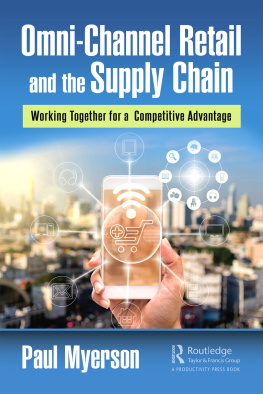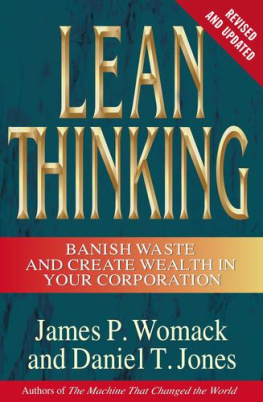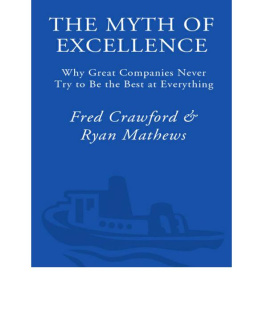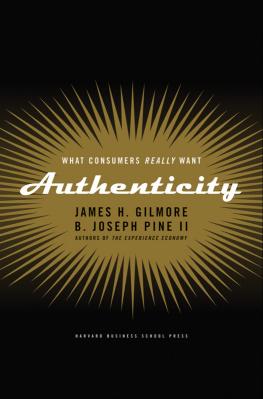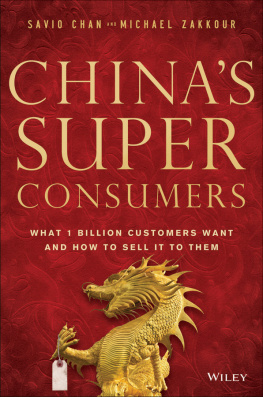
Also by James P. Womack and Daniel T. Jones
Lean Thinking
The Machine That Changed the World
(with Daniel Roos)
The Future of the Automobile
(with Alan Altshuler, Martin Anderson, and Daniel Roos)
Seeing the Whole: Mapping the Extended Value Stream
LEAN
SOLUTIONS
How Companies and Customers
Can Create Value and Wealth Together

James P. Womack
and Daniel T. Jones
FREE PRESS
New York London Toronto Sydney

FREE PRESS
A Division of Simon & Schuster, Inc.
1230 Avenue of the Americas
New York, NY 10020
www.SimonandSchuster.com
Copyright 2005 by Solution Economy, LLC
All rights reserved,
including the right of reproduction
in whole or in part in any form.
FREE PRESS and colophon are trademarks
of Simon & Schuster, Inc.
For information regarding special discounts for bulk purchases,
please contact Simon & Schuster Special Sales at 1-800-456-6798
or business@simonandschuster.com
Designed by OffPiste Design
Manufactured in the United States of America
1 3 5 7 9 10 8 6 4 2
ISBN-13: 978-0-7432-7778-5
ISBN-10: 0-7432-7778-3
eISBN-13: 978-0-7432-9117-0
For Carrie and Katherine,
Two thoughtful consumers of the future,
who often got me what I wanted
when I wanted where I wanted while writing this book.
JPW
For Michael, Kate, and Simon,
Three thoughtful participant-observers of
provision, who often told me whether I was
getting it right.
DTJ
For Pat and Anne,
For bearing with us while we wandered off
on consumption-stream walkssometimes
only in our mindsand then huddled in
our garrets to write up our findings.
DTJ and JPW
LEAN
SOLUTIONS
Preface
From Lean Production to Lean Solutions
In the summer of 1982 we had a revelation. We were visiting a series of companies in Japan, trying to understand why they were winning in global competition. Then we encountered Toyota.
We quickly realized that this company was quite different from the others we had seen. Toyotas success lay in brilliant management of its core processes: the series of actions conducted properly in the correct sequence at the right time to create value for customers. Its management of product development and production and its collaboration with suppliers and customers in Japan were far better than anything we had ever encountered.
At the moment of revelation we turned to each other and said, Its not brilliant product innovations or culture or a weak currency or strong government support that makes this company stand out in global competition. Its the brilliant focus on core processes. This was an exceedingly useful insight, because quirky product brilliance or culture-specific advantages cant be copied. But superior process management can.
It took us a while, but by 1990 we were able to describe
We proposed five simple principles to guide any firm:
Provide the value actually desired by customers. Resist the urge to work forward from existing organization, assets, and knowledge to convince customers that they want what the firm finds easiest to provide.
Identify the value stream for each product. This is the sequence of actions (the process) needed to bring a good or service from concept to launch (through the development process) and from an order into the hands of the customer (through the fulfillment process). Challenge every step in these processes to see if they really create value for the customer. Eliminate the steps that dont.
Line up the remaining steps in a continuous flow. Eliminate waiting and inventories between steps to slash development and response times.
Let the customer pull value from the firm. Reverse the push methods used by firms with long response times, which try to convince customers that they want what the firm has already designed or produced.
Finally, once value, the value stream, flow, and pull are established, start over from the beginning in an endless search for perfection, the happy situation of perfect value provided with zero waste.
As the years have passed, we have been cheered that the internal processes in many organizations are improving. The simplest indicator is that most manufactured goods work a lot better today and cost less to buy than when we started our collaboration. For example, defects per car have fallen steadily in the auto industry, even as the real price of a motor vehicle of a given specification continues to decline. And we have been equally gratified to discover that lean production works in every company, industry, and country where it is seriously tried.
Meanwhile, Toyota marches from victory to victory in global competition as it closes in on General Motors for the leadership of the world car industry. By contrast, most of the other Japanese firms we encountered on our 1982 visit have failed or fallen by the wayside. (Honda is still independent and healthy, but Nissan is controlled by Renault; Mazda is part of Ford; Subaru, Suzuki, and Isuzu are tightly tied to GM; and Mitsubishi has suffered a dramatic loss of market share.)
But curiously, despite a growing variety of better products with fewer defects at lower cost available from a growing range of sales channels, the experiences of consumers seem to be deteriorating. In recent years, weve frequently found ourselves discussing this phenomenon with managers. They report that when they are wearing their producer hats in the office or the factory, things seem to be getting better. But when they go home and put on their consumer hats, things seem to be getting worse.
And we have felt this acutely in our own lives. It seems that every conversation the two of us have, working as busy authors separated by an ocean, starts with an account of a consumer frustration that has gotten in the way of getting our work done:
The custom-built, delivered-in-three-days computer that refuses to work with the printer, the other computers in our home offices, and the software from different providers.
The car repair requiring many loops of mis-communication, waiting, and complaints about work done wrong.
The long drive to the big box retailer, stocking tens of thousands of different itemsmost of them better and cheaper than those available 25 years ago, only to return home without the one item we actually wanted.
The medical procedure that was deeply impressive from a technical standpoint yet unpleasant and time-consuming from a personal standpoint.
The business trip with endless queues, handoffs, and delays.
The exasperation of help desks and support centers that neither help nor support.
Consumption should be easier and more satisfying due to better, cheaper products. Instead it requires growing time and hassle to get all of our goods and services to work properly and work together. Stated another way, todays consumers are often drowning in a sea of brilliant objects. And this seems very strange when we stop to consider that satisfying consumptionnot just making brilliant productsis the whole point of lean production.
The Emerging Challenges of Consumption
In the late 1990s, we passed off these observations as short-term phenomena, the consequence of the bubble economy when consumers were offered many new capabilities supported by immature technologies. Surely things would get better in the future.
Next page


